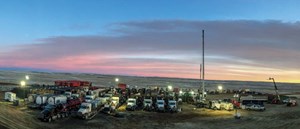What's new in exploration
I was recently told by an oil and gas accountant that one of his larger independents stated that there was not a shortage of geo-talent, due to aging demographics. The quote was, “there are too many geologists, and always has been.” Recall this 2015 Morgan Stanley headline, “The Worse Than 1986 Downturn In Oil Prices Has No Parallel In Recorded History!” I remember 1986 vividly. Marathon Oil had just come off its best financial year, ever, at the end of 1985 [November, oil at $31.72/bbl]. By mid-1986 [March, oil at $10.42], we were preparing for the first layoff in the near-100-year [founded 1887] history of the company, thanks to cash flow issues with our new parent, USX. No one in Washington cared, no one in the media vocalized a sad song, no bail-out, no back pay.

Remember 1974? Oil had been $5/bbl. OPEC [controlled by Iran and Saudi Arabia] after nationalizing the Seven Sisters, embargoed the U.S. for supporting Israel [per former U.S. President Richard Nixon]. The oil war was on. Oil priced itself, up and up, to a “catastrophic” $11.65/bbl that year. The world was coming to an end, or so we were told from the White House in 1977. Rather than proposing relief for our “too-big-to-fail” industry, former President Jimmy Carter in 1980 [oil at $35/bbl] convinced a Democratic-majority Congress to create the Crude Oil Windfall Profit Tax Act (P.L. 96-223), bringing exploration to its knees. World governments followed. Still, here we are, in spite of granite towers and business jets for executives on both sides of the politic! What are the “Dems” of today’s world saying about $55 oil? Lions and tigers and bears, oh my!
No panic. There is still much to do. Wildcat exploration (E) became delineation E in the 1980s, which became development E in the 1990s. I worked the Faroes when no one thought there was a chance to drill deep water. I worked the Mediterranean Spanish coast when 600 ft of water was the limit. I worked the shallow water over the Qatar Arch, but convinced no one at my company to drill 2,500 ft more on an existing well. However, 1,400 ft later, continuing partners discovered 17 Tcf of gas. I remember selling a barely used 2D seismic library of the Republic of Vietnam, when U.S. trade reopened.
I remember Libya, when other international companies took over our 300-MMbbl-of-oil interest, in fiduciary, because Reagan told us to get out after he bombed the royal palace. I remember Tunisia, working a serious group of vertical faults, not seismic-imageable, attempting to produce a decent oil field. The next guy did no better. Win some and lose some in this business. Persistence pays.
Total says it plans to drill 23 wells this year off the coasts of South Africa, Mauritania, Senegal, Namibia, Brazil and Guyana. More of interest is the company’s focusing its “exploration” on known fields, instead of higher-risk areas. How do you do that and call the effort exploration? Note that Kevin McLachlan, the senior V.P. for exploration, says, “the effort will be the … company’s largest in years, although the exploration budget will be similar to last year’s $1.2 billion for E&P (Reuters).” One more time, exploration gets redefined in a new/old paradigm.
Total is following the 2017 trend set by ExxonMobil, Chevron and others. ExxonMobil is reorganizing/reducing its B.U.’s from seven to three, but at least the firm says it still has new exploration ventures in its E&P. CNOOC, et.al. will try to boost “exploration” by drilling “thousands” of wells onshore China and throughout the South China Sea. Thousands sounds like field development, not exploration.
Redefinition of exploration improves employment and continued technology innovation. Real wildcat exploration in 2019 [using the 1950s definition] is estimated to be less than 5% of worldwide budgets. Exploration, impaired or not, remains key to the long term, even if it gets redefined again, as Total and most others are doing. The effort to reclaim oil and gas that we know was left behind in each and every oil/gas field is smart.
A mentor in the ‘70s told me that the “easy” oil had been found. Actually, as technology evolves, so does the idea of “easy.” He also told me that the shalely sands of the Powder River basin (Fig. 1) were never going to be of interest. Interesting, because at that time, I was working an oil shale in-situ retort experiment for the USGS/DOE out of Green River, Wyo. So far, that idea is dead. Years later, Marathon gave me a letter granting permission to hunt on their 400,000 acres of undeveloped oil shale in Colorado. I may have been the only one to get value out of there.

- What's new in exploration (November 2023)
- Management issues- Dallas Fed: Activity sees modest growth; outlook improves, but cost increases continue (October 2023)
- Industry at a glance (June 2023)
- Industry at a glance (May 2023)
- Management issues- Dallas Fed: Oil and gas expansion stalls amid surging costs and worsening outlooks (May 2023)
- Executive viewpoint (April 2023)
- Applying ultra-deep LWD resistivity technology successfully in a SAGD operation (May 2019)
- Adoption of wireless intelligent completions advances (May 2019)
- Majors double down as takeaway crunch eases (April 2019)
- What’s new in well logging and formation evaluation (April 2019)
- Qualification of a 20,000-psi subsea BOP: A collaborative approach (February 2019)
- ConocoPhillips’ Greg Leveille sees rapid trajectory of technical advancement continuing (February 2019)


